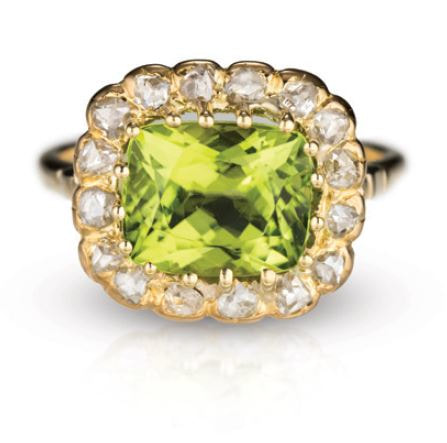PeridotThe Egyptians called peridot the “gem of the sun.” Peridot has always been associated with light. Some
believed that it protected its owner from “terrors of the night,” especially when it was set in gold. Others strung the gems on donkey hair and tied them around their left arms to ward off evil spirits. The word peridot comes from the Arabic “faridat,” which means “gem.” Most peridot formed deep inside the earth and was delivered to the surface by volcanoes. Some also came to Earth in meteorites, but this extraterrestrial peridot is extremely rare, and not likely to be seen in a retail jewelry store. Color Peridot’s color ranges from yellowish green to
greenish yellow. The most favored peridot color is a richly saturated pure grass green without any hint of yellow or brown, which is usually only achieved in gems of 10 ct or larger. Smaller examples tend to show yellowish green hues. Brown undertones lower the value of peridot. Clarity The best-quality peridot has no eye-visible inclusions,
with perhaps a few tiny black spots—minute mineral crystals—visible under magnification. Other inclusions common in peridot are reflective, disk-shaped inclusions called “lily pads.” Source Peridot is found as irregular nodules (rounded rocks
with peridot crystals inside) in some lava flows in the United States, China and Vietnam and, very rarely, as large crystals lining veins or pockets in certain types of solidified molten rock. Sources for the latter include Finland, Pakistan, Myanmar and the island of Zabargad. Treatments Peridot is rarely treated, but might have fractures that
can be filled to improve the apparent clarity. |
|
All information are courtesy of Gemological Institute of America (GIA). OR DIAMOND are not affiliated with, connected to, or associated with GIA other than selling diamonds and gemstones graded by GIA and have GIA trained staff gemologist and accredited jewelry professional on site.
Images courtesy: Bill Larson, Pala International; Jonte Berlon; Stephen M. Avery






